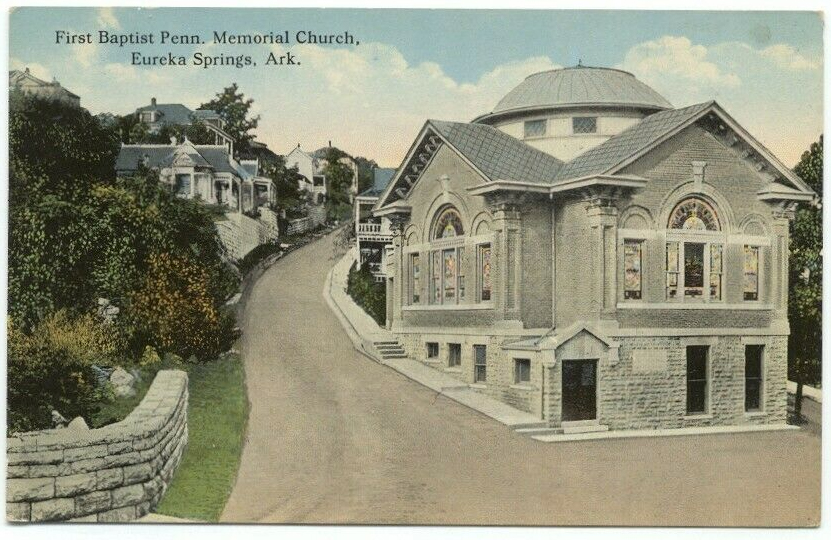A history of the First Baptist Penn Memorial Church of Eureka Springs
The church’s roots reach back to the establishment of the old First Baptist Church in August of 1880. It began with 8 charter members and met in homes until a wood frame church was erected on Elk Street, just above the Elmwood House. In 1899, some of the congregation withdrew from the church and constituted the Immanuel Baptist Church, which still stands today on the Old U.S. Hwy 62B route. Today it is known at Gavioli Chapel and is used primarily as a wedding chapel.
In 1908 there was a need for a new church building, but most of the members decided to consolidate with Immanuel Baptist Church rather than to undertake the new construction. However, a few members chose not to go with the majority, and for several years continued meeting together in private homes. Finally, February 4, 1912, six members reconstituted the First Baptist Church of Eureka Springs, and in May of that year adopted the name, First Baptist Penn Memorial Church, in honor of William Penn. Plans were made and construction of the current auditorium and fellowship hall was begun during the later half of 1912, and the finished building was dedicated October 12, 1913. The original cost of construction was almost $15,000. The educational space and pastoral living quarters were added in 1952 and 1953. After its original construction the Church soon grew and became a very central and vital part of this community.

The church reflects the influence of Byzantine architecture. The stain glass windows in the sanctuary were an early addition to the church and are a vital part of the worshipful beauty of the church. These windows, today, are almost irreplaceable works of art. As the church stands today, it has the unique distinction of being a church built on four levels with a street entrance on each of the levels. Another interesting sidelight is that the church has three separate addresses: one each on Owen, Spring and Mountain Street. This was an unusual fact that was published in “Ripley’s Believe It Or Not.”
As noted, the church is named in honor of Major William Penn, one of the early western evangelists. William Penn was born and raised in Tennessee, but after the Civil War he moved his family to Jefferson, Texas, where he established a law practice. He helped establish and lead a very successful Sunday School in the Baptist Church there in Jefferson. Because of his position as Sunday School director and because of the success of the Sunday School, Penn was ask to speak at a regional Sunday School convention at the Baptist Church in Tyler, Texas. Though he had no training as a preacher, he shared his heart from the pulpit and a revival broke out in the community such that the meetings continued daily for five weeks. Later, as others urged him, and as he came to understands God’s calling on his life, Penn became an itinerant evangelist preaching throughout the southern and western United States.
In 1888, considering retirement, Penn and his family moved to Eureka Springs. They built the beautiful stone home at the top of Mountain Street, which is know as Penn Castle. They joined the First Baptist Church on Elk Street and for several years Penn continued to travel across the South preaching in various churches as an evangelist. By 1893, Penn’s health was failing and he was not traveling very often.

Beginning December 10, 1893, however, Penn conducted revival services at his home church here in Eureka Springs. This series of meetings came to be known as the Great Revival of 1893. It actually continued until March 20, 1894. For more than three months, he preached to large congregations twice daily at the First Baptist Church.
Almost all of the evening services were filled to overflowing. Revival broke out across the city, with other churches bringing in their own evangelists. When the meetings closed there had been 346 new converts, and 335 people had sought to unite as members with First Baptist Church.
Penn preached very few times after this, as his health continued to worsen, and he passes away April 29, 1895. More than 1000 people gathered for the funeral, most having to stand outside of the over-crowed church.
When you are in the rear foyer area of the church you will see several historical artifacts.
The silver communion service, located in the display cabinet, was a gift from Mrs. Penn after the present church was completed. This had been the service set that William Penn carried with him as he conducted revival meetings across the country. Also, you will want to note the display case with various historical Bibles. Included in that case is a copy of “Harvest Bells”, which was an early frontier hymn book published by William Penn. He also wrote and composed a number of the hymns.